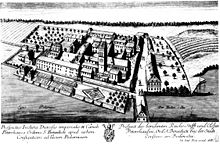Petershausen (Constance)
|
Petershausen
District town of Constance
Coordinates: 47 ° 40 ′ 6 ″ N , 9 ° 10 ′ 51 ″ E
|
|
|---|---|
| Height : | 401 m above sea level NHN |
|
Location of Petershausen in Konstanz
|
|
Petershausen is just north and justice Seerhein located district of Konstanz . The district was named after the Domus Petri monastery of the same name .
history

A Roman settlement existed at this point , which was abandoned in the 3rd century. Later the area came into the possession of the Reichenau monastery . Only with the founding of the Petershausen Monastery by the Konstanz Bishop Gebhard around the year 983 did a settlement emerge again, from which a double village emerged: to the east of the monastery the upper village, which was named after an inn "Zum Sternen" there, also as the star district, and southwest of the monastery on the road to Reichenau, the lower village, where the monastery servants lived. The villages developed relatively independently, but came more and more under the influence of the city of Konstanz and around 1600 became the Konstanz suburb of Petershausen.
The development of Petershausen was initially contemplative. With the secularization of the monastery in 1802 and the subsequent partial decay of the monastery buildings, Petershausen lost an important development engine. The remaining usable buildings of the monastery were used as a military hospital and expanded into barracks from 1850 . The settlement of the military and, from 1863, the connection to the Badische Staatsbahn then ensured an upswing for Konstanz as a whole and Petershausen in particular. Since the city of Konstanz was limited to the south by the border with Switzerland , the increase in the number of inhabitants had an impact on the growth of Petershausen, which spread around the former monastery. Along the shores of Lake Constance east of the star district and to the north on the road to Wollmatingen , promenades and villa districts emerged. In 1912 Petershausen received its own elementary school , today's Theodor-Heuss-Realschule. The construction of the new church planned for 1913 was delayed and could only be consecrated 17 years later due to the First World War and inflation . School, church and rectory formed the new center of the Petershausen district. Between 1914 and 1917 another barracks, the Jägerkaserne , was built in the district.
The star district existed until the Rhine bridge was expanded in 1936–1938. The entire quarter was demolished for the multi-lane street layout and the railway underpass towards Staad . The name of the traffic junction "Sternenplatz" still reminds of the former village.
swell
- The Chronicle of the Petershausen Monastery. Edited and translated by Otto Feger, 2nd edition, ( Schwäbische Chroniken der Stauferzeit, Vol. 3), Sigmaringen 1978, ISBN 3-7995-6040-8 .
literature
- Sybille Appuhn-Radtke: 1000 years of Petershausen. Contributions to the art and history of the Benedictine Abbey Petershausen in Constance. Konstanz 1983, ISBN 3-7977-0109-8 (exhibition catalog).
- Franz Hofmann: From the estate to the factory, from the industrial wasteland to the promenade - The Petershauser Seerheinufer. In: Hegau, 69 (2012), pp. 155–176.
- Ralph Röber: Monastery, village and suburb of Petershausen. Archaeological, historical and anthropological studies ( research and reports on the archeology of the Middle Ages in Baden-Württemberg, Vol. 30). Stuttgart 2009, ISBN 978-3-8062-2337-8 .
- Willi Sutter: Petershausen. Monastery - churches - barracks. In: Delphin-Kreis (Ed.): Das DelphinBuch ( Konstanzer contributions to history and the present, vol. 10). Konstanz 2010, ISBN 978-3-939142-57-7 , pp. 37-65.
Web links
- Web presence of the Catholic pastoral care unit Konstanz-Petershausen with its three parishes on the right bank of the Rhine, Sankt Gebhard, Brother Klaus and Sankt Suso
- Church leader St. Gebhard
Individual evidence
- ^ Since 1214 imperial abbey .
- ↑ Südkurier : Open Monument Day.


